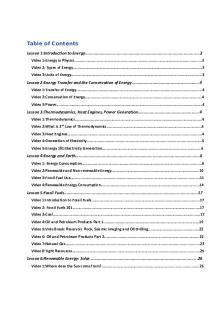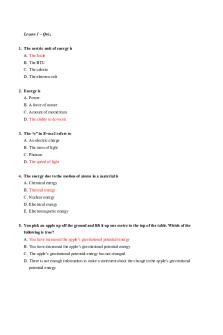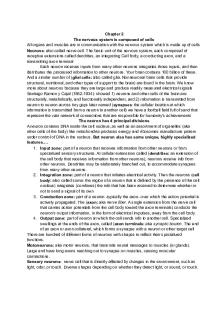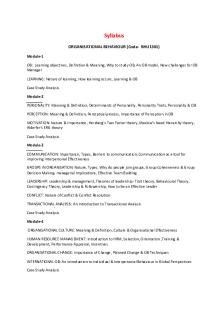PHYS 273 Full Class Notes PDF

| Title | PHYS 273 Full Class Notes |
|---|---|
| Course | Energy and Environment |
| Institution | Concordia University |
| Pages | 80 |
| File Size | 1.9 MB |
| File Type | |
| Total Downloads | 289 |
| Total Views | 673 |
Summary
Energy in PhysicsAnalogy with Money Define my WEALTH IN assets with: wallet, investments, checking account Transfer from checking to wallet – but decide instead to invest it In energy When we define the system (wealth) the total amount of energy within the system does not change - When something cha...
Description
Lesson 1 Wednesday, January 16, 2019
3:01 PM
Energy in Physics Analogy with Money - Define my WEALTH IN assets with: wallet, investments, checking account - Transfer from checking to wallet – but decide instead to invest it In energy - When we define the system (wealth) the total amount of energy within the system does not change - When something changes outside the system – the total will change - Energy coming in and out in the context of a fixed system Work and Energy in Physics -
The word energy and work are different Energy: ability to do work Work: Transfer of energy Circular but important in making calculations and predictions of the natural world Work: the transfer of energy Ex: taking a box at rest and pushes it across the floor – wasn’t moving but is now moving
- Work = Force x Distance - Held still & No distance = No work (although felt like work none was done) - Lifted up from ground = Work Types of Energy 1. Chemical Energy: stored in chemicals and materials: Wood, coal, paper, natural gasses in form of heat energy
2.
3.
4.
5.
6.
7.
a. Charged electric batteries b. Food in stomach Kinetic Energy: The energy an object has due to its movement a. Depends on the mass and the velocity squared b. Mechanical energy Thermal/Heat Energy: associated with random molecular motions within any substance a. Increases of heat energy contained in any substance result in temp. increase and conversely decrease of heat energy produces decrease in temp. b. Increase in temp = faster moving molecules Potential Energy: energy an object has that’s associated with its position of an object when some force is acting on it a. Most common is gravitational potential energy b. The higher the object the more gravitational energy is has c. Also a type of mechanical energy Electrical Energy: energy that is stored by charges (+/-) in their electric fields a. Nothing can be seen with the eye but it is stored and can be released as other forms b. Ex: in storm clouds the electrical energy is stored in between the clouds and ground which acquire opposite charges Electromagnetic radiation: light; can be visible or not (one small range of the spectrum is visible) a. Form of a wave that carries energy b. Shorter or Longer wavelength sides of the visible ones that still not visible but carry energy Nuclear/Mass Energy: Correspondence between mass and energy a. Einstein’s theory of special relativity: mass can be converted to energy and energy can be converted to mass b. How much energy is stored in some amount of mass c. E = mc2 Amount of mass energy is equal to the amount of mass times the speed of light (30000km/second) squared
In this Course
Joule: metric unit of energy - One Joule = One metric unit of force (the newton) X One metric unit of distance (the metre) - W = F (newton) X D (metre) The British Thermal Unit (BTU): the amount of heat energy which must be given to a known amount of water to increase its temperature by a given amount. - One BTU = amount of heat energy required to raise the temp. of one pound of water by one degree Fahrenheit. - In discussions of fuel and insulation Calorie: defined in terms of heating water. Is the amount of energy required to raise temp. of one gram of water by one degree Celsius, or the amount of energy given off when one gram of water cools by one degree Celsius - In North America it is actually measured in kilocalories by the above definition (1000 kilocalories is actually 1 million calories) Electron-Volt (eV): Very small amount of energy which is useful when working with tiny charged particles (like electrons). - It is the amount of energy an electron gains if accelerated by a 1-volt electrical potential.
Reading Chapter 1: Energy Fundamentals Energy in society: many times more energy in the form of engine fuel goes into the agricultural enterprise than is obtained in the useful food Calorie content of the food produced - 82% of energy supply in US = fossil fuels (coal, natural gas, oil) Concern for Fossil Fuels: 1. limited amount: at a rate much slower than what we are using 2. Environmental consequences: carbon emissions
Why Do we use so much energy? - Not efficient at using what we need - Industrialized countries with higher GDP does not directly correlate with higher standards of living – but it does with energy use ***Review equation on example 1.1
Energy Basics Energy: the capacity to do work Power = energy/time -------- Energy = power X time
Lesson 2 Wednesday, January 16, 2019
3:01 PM
Conservation Of Energy Transfer of Energy and Conservation Energy: ability to do work Work: Transfer of Energy
Simplified Example of transfer energy: Santa sliding down sleigh on a hill -
Top of the hill = zero kinetic energy Gains kinetic energy after picking up speed down the hill Top of the hill = high potential (gravitational energy) Loses potential energy as he slides down the hill Therefore, keeping all things constant (no friction for heat energy) the Potential and Kinetic energy increases or decreases as an inverted function of each other
- Potential is transformed in kinetic energy as he slides down
Energy Flow - Energy can be transformed from one type to another - This is trackable Simple Example: applied force: work done on box -> creates kinetic energy Complex Example: 1. Nuclear Energy from the sun converted into light energy (Electromagnetic waves) 2 Waves converted into chemical energy through photosynthesis of a plant
2. Waves converted into chemical energy through photosynthesis of a plant 3. Plant converted into chemical energy during digestion in a human 4. Humans applied force: work done on box into kinetic energy The Law of Conservation of Energy (not the same as conserving energy) The total energy in an isolated system (or region) cannot change. - Isolated system: Energy can neither enter nor escape the system - Energy total is conserved, it can be transferred from one form to another but not created or destroyed - Ex: Light bulb attached to a battery in a perfectly insulated opaque box o Chemical: battery o Electrical: wire to light bulb o Thermal: heats up lightbulb o Electromagnetic: emits light - Total system has a Decrease: Chemical & Increase: Thermal / Electromagnetic (EM) - Conservation of energy inside the opaque box – all energy lost converted into different energy gained What if you take off the lid? - Chemical – Electrical – Thermal – EM - Still decrease in chemical, and increase in Thermal and EM o BUT now some heat and light is no longer conserved (which is no longer an isolated system o MUST be a closed system where the law is valid
Power: the rate at which energy is consumed or produced (amount of energy per time) -
Metric Unit = watts (W) which is s per second (s) 60 watt lightbulb (60 joules per second) Like a rate of pay = Power is like how much you get paid per hour Power = Energy/time Example 1: hairdryer (avg is 1500 W)
- 1500 Joules per second - If it runs for 5 minutes then 1500 x 300seconds = 450,000 Joules - Or 450 KJ Example 2: TV 20 W - 20 x 300 seconds = 6000Joules or 6 KJ Example 3: Motorcycle - Imagine is accelerates after being at a stop sign - Speed 50km/hr - There is power being produced and power being consumed Steps of energy increase and decrease 1. Produced: decrease in chemical energy (gas) 2. Consumed: increase in kinetic energy (motor cycle and the rider) Engine producing power – by burning fuel Power being consumed – in form of increase kinetic energy and thermal energy increasing
Lesson 3 Tuesday, January 22, 2019
1:45 PM
Thermodynamics, Heat Engines, Electrical Power Generation Laws of thermodynamics Relation between law of conservation of energy (COF) - Entropy 1. First law: - The change in internal energy of a system equals the net heat transfer into the system minus the net work done by the system o This is the same as the principle of COF o Change = energy in (heat created) – energy out (work done by the system) -
Example: -
Engine of the car – heat input from burning gas Combustion = heat input Output = radiation and work done by the engine Can’t get more heat out and work done then the amount of heat in
2. Second Law: - Heat (or energy) transfer occurs spontaneously from higher to lower temperature bodies but never in reverse
-
The direction taken by spontaneous processes – many occur in one direction only (and are irreversible) o “Just happens” hot piece of metal with cold piece of metal – the diffuse into the same temperature – on direction only o Total amount of energy is the same o If you brake – the braking creates heat, loose energy in heat form – you can’t heat up your brakes from the outside and make them start going – only work from one way Example:
-
Water in a glass with ice – the ice heats up and the water cools down: can only occur in one direction Entropy: Is a measure of the disorder (or randomness) of a system
-
Mix up balls in a random distribution More order = lower entropy = more useful energy Less order = higher entropy = less useful energy Heat Death: eventually the atoms in the universe will be diffused – 10^26 years SO: IN AN ISOLATED SYSTEM THE ENTROPY OF THE SYSTEM INCREASES OVER TIME
-
The randomness of the ice cubes in the water is less ordered
-
Diffusion of sugar in a solution Summary:
1. The randomness of the system can not decrease, this limits the amount of useful energy available 2. Initially the system is more ordered, energy is stored in the battery and cool box 3. Later there is less energy in the battery and there is more thermal energy (random motion molecules) in the box 4. We can’t put the energy back in the battery 5. The total energy of a system is the same but there is less useful energy Entropy Increase = Less useful energy Heat Engines: taking thermal energy and converting to mechanical -
-
-
The heat energy released by burning a single match is about the same amount of energy required to lift a pint of beer to the top of Montreal’s tallest building Fossil Fuels and converting process: o Direct heat, light is used o Heat engine used § Mechanical energy (drive car) • Electrical energy • Transportation, industry Energy Content of Fuel 2 chemical reactions possible: burn hydrocarbons
C + O2 -> CO2 + heat energy o H2 + O -> H2O + heat energy Heptane burned = 1.2 million calories of thermal energy released o
-
What’s a Heat Engine? -
-
-
Any device that can take energy from a warm source and convert a fraction of this heat energy to mechanical energy It relies on a temp difference between the heat source and the heat sink (cold)
Coal furnace: often built on water to heat sink, and the heat engine takes some of the energy and converts to mechanical energy to fuel a generator Fraction of heat source energy is converted into work (mechanical energy) Efficiency:
-
Efficiency of a heat engine tells us how much of the input heat energy is turned into useful mechanical work (42% in best power plants) o Example: § If every 1000J of energy put into a heat engine
If every 1000J of energy put into a heat engine (source), 50J is converted to mechanical energy § Efficiency = (Work done/energy put into the system) x100% § Efficiency = (50/1000) x 100% = 5% Since the second law of thermodynamics – it is not possible to turn all of the input energy into mechanical energy Nicholas Carnot proved the best efficiency possible by a heat engine is: o Best Efficiency = (1 – T cold/ T hot) x 100% § Limit based on the laws of physics, not how good we design an engine §
-
Example using the Kelvin temp scale which is relative absolute zero (-273 celsius) -
O Celsius = 273K (add 273) Typical temp in a coal fired electric power plant might be 825 K in the boiler (source)and use cold water cooling tower (sink) at 300 K o 825 K = 552 Celsius o 300 K = 27 Celsius o E (best) = (1 – T cold/ T hot) x 100% o E (best) = 1 – 300/825) x 100% § = 64% § If I produce 1000J of burning energy, my max is 640J of energy produced Generation of Electricity
-
How do we convert mechanical energy into electrical energy? – Michael Faraday in 1800s Electric currents and magnetic fields – trying to produce a current with a magnetic field o Noticed that current was produced for a short time when switched on or off o Change in magnetic field produced currents Experiments:
1. Opening or closing switches creates a momentary current 2. Push or Pull coil through the magnetic field 3. Pushing a bar magnet into a coil or pulling it out momentarily Faraday’s Law of Induction: -
Changing magnetic fields through a wire coil results in an electrical current through that coil Electrical Generator:
Through the process of electrical induction mechanical energy can be transformed into electrical energy -
By turning the wire loop – the magnetic field passing though the loop changes which generates a current (electrical energy) Thermal into Mechanical into Electrical o Most of the electricity we use is from a form of conversion : § Burning fossil fuels, Turn turbines, Wind, Water Energy 101 – Electricity Generation:
-
Mined, harnessed, collected from the earth Some are unlimited some are limited For every energy source a chemical or thermal reaction is needed to produce useable energy Mostly thermal power plants : coal, natural gas, biomass, uranium o Used to heat water and produce steam which then powers a turbine and generates electricity o The rotor turns and connects to a magnet Transfer of electricity is difficult – too much power will crash the submission channel
-
Electricity grid = 4 large grid systems Transformer helps transport energy 2x
Lesson 4 Thursday, January 31, 2019
1:19 PM
Energy and the Earth Concepts: -
How we use energy: renewable and non-renewable The way which we consume energy Energy Consumption
-
-
-
Energy Use per Capita: o The total amount of energy divided by the number of people in that country o Lower GDP: Egypt and India o Higher GDP: Canada, States Approx. 20% of the worlds population live in highly developed countries These countries account for 60% of energy use o North America and Rapid Growth: more consumption per person in wealthier countries, BUT more people has an effect on total energy consumption o India, China, Iran growth from trade o A million billion BTU Generally, countries have a similar distribution of consumption: transportation, industrial, commercial,
residential World Projections for the future: -
OECD countries (high dev.) show slower rate of growth than non-OECD 2040 = non-OECD have more consumption Canada = high Industrial and Transportation but generally decrease GR in future Renewable and Non-renewable (exhausted or never consumed to completion)
-
-
-
Non-renewable: fossil fuels; coal, oil and natural gas o Depending on the rate of use (100 years) o Not being generated fast enough for consumption o Uranium 235: nuclear fission power generation – could be depleted over several decades if used more vigourously o Geothermal: the lifetime of geo sites varies but can deplete Renewable Resources: Based on solar energy o Direct sun, wind, hydroelectric, ocean thermal, biomass o Limited only by the lifetime of the sun o The rate is not affected by the lifetime of the source Renewable not based on solar: o Geothermal: can be locally depleted but ill renew over 100 of years o Tidal: gravitational interaction between earth and moon
Fossil Fuels Consumption -
-
Consumption and production (implications) % of total energy that comes from FF o Mostly all the world: 50% dependent o Canada vs US – 74% : 83% o Iceland has the lowest: mostly use geothermal Highly dev. countries have a decrease in percent of FF use (doesn’t mean general energy decrease) Change in Coal consumption: declining in OECD, but increase in non-OECD (Asia) Change in Oil and Natural Gas: petroleum has plateaued in North America, steady increase in the world and Asia o Dry natural gas: increase in North America Sankey Diagram Fossil Fuels Alternative
-
Solar, biomass, Renewable Energy Consumption
-
Alternative and Nuclear Energy: o Clean energy is non-carbohydrate energy that does not produce carbon dioxide when generated § Hydropower nuclear geothermal solar and others
Hydropower, nuclear, geothermal, solar, and others o Canada: 24% hydro production o US: 12% alternative % of total energy Use o Increase in high income countries o Canada highest alternative (more than world average) §
-
Electricity Generation in Canada -
2015: hydro #1 2040: hydro #1 Most electricity is produced by hydro, but our main energy source is fossil fuel o % increase projection for: § Natural gas, wind, solar o % decrease projection for: § Nuclear (depending on politics), coal, hydro (small change)
Lesson 5 Saturday, February 9, 2019
4:15 PM
LESSON 5: FOSSIL FUELS OVERVIEW Coal: a black, combustible solid composed mainly of carbon, water and trace elements found in Earth’s crust; formed from ancient plants that lived millions of years ago. Oil: Depending on the type of oil, it is a thick, yellow to black, flammable liquid hydrocarbon mixture found in Earth’s crust; formed from the remains of ancient microscopic aquatic organisms. Natural Gas: A mixture of energy-rich gaseous hydrocarbons (primarily methane) that occurs, often with oil deposits as well, in Earth’s crust.
FOSSIL FUELS 101 YOUTUBE VIDEO Fossil fuels formed from ancient plants and organisms in the carboniferous period, approximately 360 to 286 million years ago, even before before dinosaurs. Organic matter, temperature, time and pressure conditions forms various types of coal. There are three types of fossil fuels: coal, oil and natural gas. Coal: Formed from ferns, plants and trees, which hardened due to pressure and heat.
Oil: Formed from small organisms like zooplankton and algae where pressures cause the more complex organic matter to decompose. Natural Gas: Formed by the same processes of oil only it was exposed to more heat and pressure causing it to further decompose and turn into a gaseous form. Fossil fuels are the largest emitters of green house gases.
COAL Coal reserves: Most abundant fossil fuel, what we see is it’s mostly distributed in the northern hemisphere. World’s known coal reserves could last us approximately 200 years at current rate of consumption. Running out of coal is not the main issue regarding how much we use and how much we should be using. There is quite a bit more coal we know about but it’s much more difficult and expensive to extract. What we see in the map and bar charts are coal that we CAN extract as it is much more financially viable using the tech we already have today.
COAL MINING: SURFACE For surface mining, this is used when coal is near the surface so used for shallow coal deposits. In general the idea is to remove the soil and rock exposing the coal so then you can remove the coal. This soil and rock is called the “overburden.” Three different ways in which this is done: 1. Strip Mining: Long narrow strips are mined; the overburden from one strip is then put into the previously mined strip 2 O it i i Di i th l d t t th l
2. Open pit mining: Dig a giant hole and extract the coal 3. Mountain top removal mining: The top...
Similar Free PDFs

PHYS 273 Full Class Notes
- 80 Pages

PHYS 273 FULL Notes
- 97 Pages

Phys-273-Notes - Lecture notes 1-12
- 55 Pages

PHYS 273 NOTES INCLUDING test bank
- 50 Pages

PHYS 273 Midterm Notes Lessons 1-7
- 61 Pages

PHYS 273 QUIZ Question BANK
- 9 Pages

Dante\'s Inferno Full Class Notes
- 12 Pages

PSYC 273 Chapter 2 Notes
- 10 Pages

Phys 91173 electrcity notes
- 8 Pages

FULL Notes
- 229 Pages

Full notes
- 102 Pages

1189 BIOL 273 - course
- 14 Pages

PHYS 1000 - Unit 3 Notes
- 7 Pages
Popular Institutions
- Tinajero National High School - Annex
- Politeknik Caltex Riau
- Yokohama City University
- SGT University
- University of Al-Qadisiyah
- Divine Word College of Vigan
- Techniek College Rotterdam
- Universidade de Santiago
- Universiti Teknologi MARA Cawangan Johor Kampus Pasir Gudang
- Poltekkes Kemenkes Yogyakarta
- Baguio City National High School
- Colegio san marcos
- preparatoria uno
- Centro de Bachillerato Tecnológico Industrial y de Servicios No. 107
- Dalian Maritime University
- Quang Trung Secondary School
- Colegio Tecnológico en Informática
- Corporación Regional de Educación Superior
- Grupo CEDVA
- Dar Al Uloom University
- Centro de Estudios Preuniversitarios de la Universidad Nacional de Ingeniería
- 上智大学
- Aakash International School, Nuna Majara
- San Felipe Neri Catholic School
- Kang Chiao International School - New Taipei City
- Misamis Occidental National High School
- Institución Educativa Escuela Normal Juan Ladrilleros
- Kolehiyo ng Pantukan
- Batanes State College
- Instituto Continental
- Sekolah Menengah Kejuruan Kesehatan Kaltara (Tarakan)
- Colegio de La Inmaculada Concepcion - Cebu


